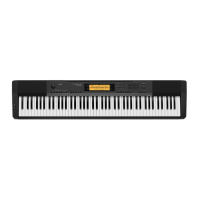E-18
Sampling Sounds and Playing Them on the Digital
Piano
You can use the Digital Piano to sample a sound from a
microphone, and then play the sound with keyboard keys. For
example, you could sample the bark of your dog and then use
the sound in a melody. The sampling feature is a great way to
create new sounds that are highly creative.
• Turn off the microphone and the Digital Piano before
connecting them.
1.
Connect a microphone.
• You also could connect a commercially available
microphone.
• You cannot sample sounds input from through the AUDIO
IN jack.
2.
Turn the volume levels of the Digital Piano
down.
3.
Turn on the microphone and then the Digital
Piano.
4.
Use
em
(MIC VOLUME) to adjust the volume
level of microphone input.
• It will take a few seconds after you turn on the Digital Piano
before you will be able to use the microphone.
• Sampled sounds are recorded in monaural.
clcl cmcm cncn coco cpcp cqcq
brbrbobo bpbp btbtbsbs ckck
Connection and Preparation
MIC IN/SAMPLING jack

